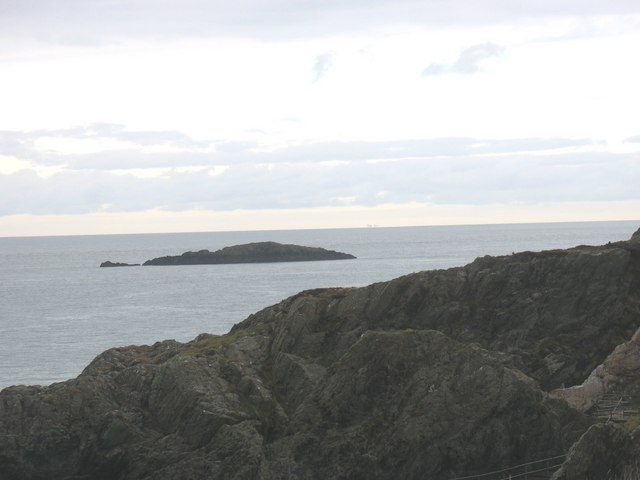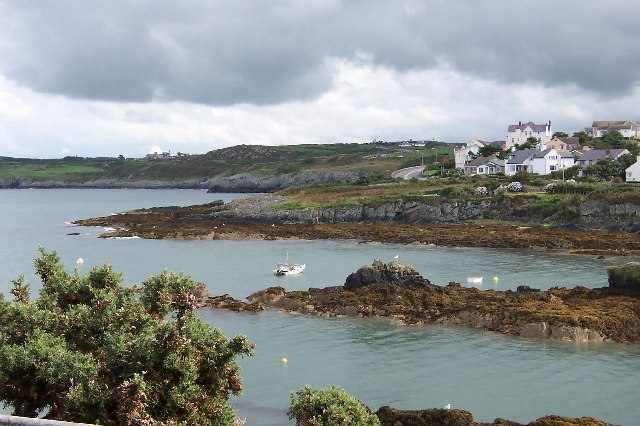Bull Bay is a charming little village, with pretty views and a cove that belongs in an Enid Blyton book. Located on the northern coast of Anglesey, Bull Bay is actually the most northern village in Wales. It looks out onto the Irish Sea and is a prime spot for fishing, rowing and escaping the busyness of the city. It is best known for its calm waters inside the bay; the town’s welsh name – Porth Llechog – actually translates to sheltered bay.
East Mouse Island
East Mouse Island is a stunning rocky island that is home to many fascinating caves and is bursting with history. Situated in the bay, it’s surrounded by crashing waves and the rocky terrain is truly breathtaking. Some of the rocks here are over 570 million years old, making them some of the oldest rocks in Wales. Here you can explore many caves and inlets, marvel at the remarkable views of the bay, and take in the historic atmosphere.
East Mouse Island was the site of the SS Dakota shipwreck. The SS Dakota was built in 1874 and hit the island on 9 May 1877, sinking to its watery grave. Despite the tragedy, all 218 souls on board were saved.
The Island’s stunning rock formations, stunning views and fascinating history make it a must-visit destination for any explorer.

The Bay itself
Bull Bay is a quiet yet popular destination that provides stunning views of the Irish Sea and is home to a beautiful shingle and rock beach. Bull Bay is a popular spot for recreational activities, such as fishing; it has a large slipway, making it easy to access the sea. There are plenty of popular fishing spots. Be warned though, it’s not unusual for the tide to quickly change.
On the beach, you’ll find plenty of interesting rock pools, perfect for exploring; the sheltered location means that the water is calm and perfect for swimming. There are also no dog restrictions in Bull Bay, so feel free to bring your furry friends along.
Walks
A short walk from the beach up to the cliffs rewards you with spectacular views over the Irish Sea. Many paths wind through the cliffs and overlook the beautiful bay, providing a view of otherwise hidden bays and coves. If you go further along the eastern cliffs to Porth Wen, you’ll find plenty of seals and porpoises, often in large groups.
Alternatively, you could take a leisurely stroll along the coastal path, an 870-mile route hugging the Welsh coast, which passes by the village.
Another well-beaten path leads to the remains of Bull Bay’s forgotten history.
The Former brickworks
A fascinating industrial relic lies inconspicuously amongst the rugged cliffs and secluded bay. The former brickworks of Porth Wen once hummed with activity, with its boilers, kilns and crumbling brickwork standing as a testament to the area’s industrial past. The brickwork has since been reclaimed by crawling ivy and the surrounding landscape, but it is still very much recognisable.
Quartzite rocks, local to the area, were previously used in the production of silica bricks – an essential in the steel industry. The brickworks were strategically located so that these rocks could be transported by sea; however, the combination of many sharp rocks and no shelter made this location a hazardous pick-up point.
In the early 20th century, demand for these bricks began to wane, meaning the risk of transporting them was no longer worth the reward. The brickworks were left to decay and the site of Bull Bay’s fortifications became nothing more than a relic. Nowadays they are a photographer’s dream, offering striking views of the local landscape and a unique glimpse into a bygone era.
Wildlife
Photographers may also be intrigued by the displays of undisturbed wildlife. The area is home to a variety of species, including seals, dolphins and porpoises. Welsh birdwatchers often flock here, attracted by the variety of visiting species, including puffins, oystercatchers and guillemots.
Trireme Ynys Mon Rowing Club
Trireme Ynys Mon Rowing Club is a welcome addition to the area. Affiliated to the Welsh Sea Rowing Association, the club rows modern Pembrokeshire Longboats, Celtic Longboats and Euro boats. The club is located near the former lifeboat station.
The former lifeboat station
In 1867, the Royal National Lifeboat Institution opened the Bull Bay Lifeboat Station. The first vessel to be used in action was the 32-ft Eleanor, which saved the crew of the schooner Albion in 1871; in 1877, Eleanor also rescued 20 passengers from the SS Dakota. In June 1924, the RNLI closed the station after 58 years of service. During that time, the Bull Bay lifeboats deployed 41 times, saving 63 lives and 7 ships.
Golf course
For any Golf enthusiast, Bull Bay Golf Course is the most northerly golf course in Wales! This incredible course opened in 1913, funded by a local aristocrat and designed by the renowned Herbert Fowler. With its breathtaking views of the Irish Sea and Snowdonia National Park, Bull Bay Golf Course is an unmissable experience for all golfers!
Bull Bay is a beautiful little village with a wealth of history and a lot to offer. It is a sweet spot for fishing, exploring and admiring the scenery.
Cover Image: Geoff Barber / Bull Bay

